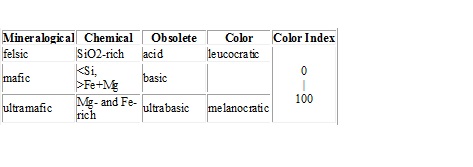 | Introduction to Igneous Rocks |
Compositional |
See http://plate-tectonic.narod.ru/petrographyigneouslinks.html
C http://ijolite.geology.uiuc.edu/08SprgClass/geo436/lectures.html
http://ijolite.geology.uiuc.edu/08SprgClass/geo436/436%20lectures/L9-Igneous.html
A. History
-Description was the first emphasis > groupings
-Classification > genetic interpretation > refined classification
-Rocks defined on basis of texture and composition
B. Terms
-Textural : phaneritic (Coarse (>5 mm)/Medium (1-5 mm)/Aphanitic = fine (<1 mm)/Fragmental = made of pieces of igneous material (crystals, glass, rocks)
-Porphyritic = 2 distinct grain sizes - 2 stages of cooling: phenocrysts = larger grains; groundmass = smaller grains
-Compositional
II. International Union of Geological Sciences (IUGS) classification
A. Determine mode = volume % of minerals present
-Method: point counting
-Find the following: Q'' = % quartz;/P'' = % plagioclase > An5/A'' = % alkali feldspar;/F'' = % feldspathoids/M = % mafics.
-Many igneous rocks can be described with Q'' OR F'', + A'' and P'' (Q and F don''t coexist) : if sum > 10, then recalculate QAP or FAP to 100% (phaneritic rocks and volcanic) : if sum < 10, recalculate O-Py-P or O-Opx-Cpx to 100% .
B. Felsic lutonic rocks
-2 parts, depending on amount of silica (Q vs. F) Note this ~Ne-Q double binary eutectic system
-QAP: most rocks have <60% Q, so granitoids and quartzolite are rare ; left side: add qualifier specifying alkali feldspar. Ex: orthoclase syenite or microcline granite ; below 20%Q, triangle is divided by A/P ratio into A-syenite, syenite, monzonite, monzodiorite; right side: problems near P. Diorite vs. gabbro distinguished by An content of P or by %SiO2 - neither shows on QAP diagram => need other diagram
-FAP: less common, so fewer divisions. Rock names are modified with specific feldspathoid.
C. Mafic and ultramafic plutonic rocks
- pyroxene is not distinguished and rock contains plag (gabbroic rocks)
- pyroxene separated into Opx and Cpx with no plag (ultramafic rocks)
-Peridotite is a general name for ultramafics with >40% O; pyroxenite for Ol<40%
D. Volcanic rocks
- equivalents of plutonic rocks in QAP and FAP diagrams
- trouble near P => (chemical classification)
E. Other rock groups with separate classification
-Fragmental rock
-Hypabyssal rocks (shallow intrusives)
-Carbonatites (calcite, dolomite - Oldoinyo Lengai, Tanzania)
-Lamprophyres (alkali-rich, mafic)
-Spilites and keratophyres (sodic basalts and andesites with hydrothermal alteration - ocean floor)
III. Normative classification
A. Def: calculated mineralogical composition based on a standard conversion of a whole-rock chemical analysis into the formulas of common minerals.
-Oxides are allocated to simple anhydrous end-member formulas of the rock-forming and common accessory minerals.
-These are the minerals that would form under low pressure, so mode ~ norm for volcanic rocks.
-Acts as a "common denominator" to compare rocks.
-Particularly useful for rocks that are too fine-grained for point-counting, or are glassy.
-Originally devised by 4 petrologists: CIPW norm. Typically expressed as wt%
B. Method
-How to distribute 13 oxides among many common minerals?: Ca could go to anorthite, pyroxene, wollastonite; Si goes into many at various proportions.
-Process is simplified by petrographic constraints - only certain combinations work.
-CIPW''s process has worked!
-Norm calculation can now be justified thermodynamically.
